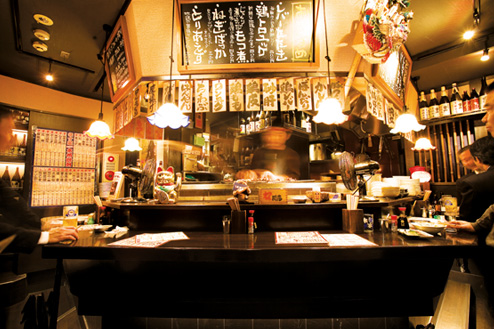Gay & Lesbian
Japan has an interesting take on homosexuality. While the numbers of gay men and women who are open about their sexual orientation are still small, popular culture is full of not-so-subtle references. In kabuki productions, men play both male and female roles, while at the hugely popular takarazuka shows, women dressed as male characters attract legions of female fans. Then there’s the long-running transvestite cabaret at Roppongi’s Kingyo.
In 2005, television audiences couldn’t get enough of actor Masaki Sumitani, better known by his stage name Hard Gay, whose trademark act involved donning a black leather Village People costume and humping things. While some would argue this widespread infatuation with Hard Gay signals the readiness of the public to accept homosexual activity, some gay organisations decried the behaviour, noting that his overt sexuality was clearly just a mockery. Indeed, his popularity faded when he was spotted on a date with a woman. Ask any Tokyo resident where to find a gay-friendly bar or party, and undoubtedly you’ll be directed to Shinjuku’s Nichōme district. The relatively tiny neighbourhood is said to be home to over 200 gay bars, and this number may not be an exaggeration. Virtually every building is stacked from top to bottom with businesses catering to the GLBT community. Many of the bars are men only and a minority are women only, but many popular establishments are open to all comers, regardless of gender or sexual orientation.
Barely beneath the surface, the gay and lesbian clubbing scene is thriving. Some of the city’s biggest and most popular nightclubs regularly host events marketed to the gay and lesbian community under the ‘Gay Mix’ or ‘All Human Mix’ banners. The most popular of these parties are The Ring at the Warehouse in Azabu-Jūban, Glamorous at Shibuya’s Rock West (www.rockwest.jp) and Shangri-La at far-flung super club Ageha. Gold Finger (www.goldfingerparty.com) is one of the most popular all-girl parties.
Nichōme’s clubs also see a steady stream of gay and lesbian clientele every night of the week. Promoter Tokyo Gay Night (www.tokyogaynight.net) throws occasional blow-outs at Shinjuku’s cavernous Club Code that attract upwards of 2,000 (mostly Japanese) men.
Generally, ‘competing’ event organisers and DJs within the gay scene tend to help each other out with mentions and links on their websites. A good place to start investigating what’s going on is Ageha’s Shangri-La page (www.ageha.com/gn/ja/links). Also check out the clubbing listings in the weekly magazine Metropolis (www.metropolis.co.jp).
Finally, two annual events bring homosexuality into the public eye. The Tokyo International Lesbian and Gay Film Festival (www.tokyo-lgff.org) in July showcases works by local auteurs, while the Tokyo Pride Parade (http://parade.tokyo-pride.org/6th/english) draws thousands of participants and spectators and culminates in a celebration in Yoyogi Kōen near Harajuku station.
In 2005, television audiences couldn’t get enough of actor Masaki Sumitani, better known by his stage name Hard Gay, whose trademark act involved donning a black leather Village People costume and humping things. While some would argue this widespread infatuation with Hard Gay signals the readiness of the public to accept homosexual activity, some gay organisations decried the behaviour, noting that his overt sexuality was clearly just a mockery. Indeed, his popularity faded when he was spotted on a date with a woman. Ask any Tokyo resident where to find a gay-friendly bar or party, and undoubtedly you’ll be directed to Shinjuku’s Nichōme district. The relatively tiny neighbourhood is said to be home to over 200 gay bars, and this number may not be an exaggeration. Virtually every building is stacked from top to bottom with businesses catering to the GLBT community. Many of the bars are men only and a minority are women only, but many popular establishments are open to all comers, regardless of gender or sexual orientation.
Barely beneath the surface, the gay and lesbian clubbing scene is thriving. Some of the city’s biggest and most popular nightclubs regularly host events marketed to the gay and lesbian community under the ‘Gay Mix’ or ‘All Human Mix’ banners. The most popular of these parties are The Ring at the Warehouse in Azabu-Jūban, Glamorous at Shibuya’s Rock West (www.rockwest.jp) and Shangri-La at far-flung super club Ageha. Gold Finger (www.goldfingerparty.com) is one of the most popular all-girl parties.
Nichōme’s clubs also see a steady stream of gay and lesbian clientele every night of the week. Promoter Tokyo Gay Night (www.tokyogaynight.net) throws occasional blow-outs at Shinjuku’s cavernous Club Code that attract upwards of 2,000 (mostly Japanese) men.
Generally, ‘competing’ event organisers and DJs within the gay scene tend to help each other out with mentions and links on their websites. A good place to start investigating what’s going on is Ageha’s Shangri-La page (www.ageha.com/gn/ja/links). Also check out the clubbing listings in the weekly magazine Metropolis (www.metropolis.co.jp).
Finally, two annual events bring homosexuality into the public eye. The Tokyo International Lesbian and Gay Film Festival (www.tokyo-lgff.org) in July showcases works by local auteurs, while the Tokyo Pride Parade (http://parade.tokyo-pride.org/6th/english) draws thousands of participants and spectators and culminates in a celebration in Yoyogi Kōen near Harajuku station.













